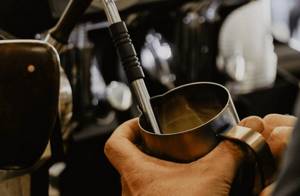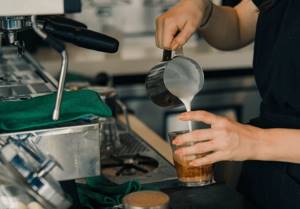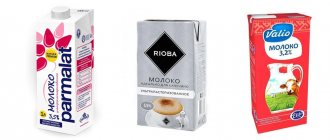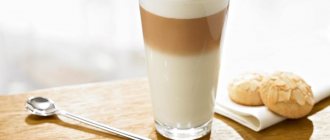How to introduce alternative milk to a coffee shop menu?
Today, alternative milk is more popular than ever. U.S. sales of such milk are expected to reach $34 billion by 2024. But they vary widely in taste and texture. So which Milk Alternative is best for the coffee shop: oat, soy, or maybe almond?
Below we will look at where and how best to use plant-based milk, what types are suitable for a coffee shop, and whether coffee with alternative milk should cost more than regular milk.
Cow's milk alternatives
Onyx Coffee Lab co-founder Andrea Allen frequently competes in the World Barista Championships. According to her, “in recent years, alternative milk has been rapidly gaining popularity.” Many of our clients drink coffee with both traditional milk and plant milk, and find their advantages in both the first and the second.
When you create a menu, it is important to understand why customers choose a particular type of milk. You also need to take into account that oase milk combines differently with different types of coffee. So let's take a look at the main types of herbal alternatives on the market.
Soy milk
For many years this variety was the only plant-based alternative. It's easy to find, inexpensive, and whips well. But not everyone likes its taste and texture, which, moreover, varies depending on the manufacturer. Some are also concerned about its health effects. In addition, according to Andrea, guests of her establishments rarely order coffee with soy milk.
Soy milk curdles when heated and when added to highly acidic coffee. To prevent this from happening, heat it slowly and not to such a high temperature as regular milk. In addition, it is advisable to combine soybeans with not very sour coffee.
Almond milk
Statistically, almond milk is the most popular alternative milk in the world. It accounts for ⅓ of total sales. Almond milk has a distinct sweet, nutty flavor. But not everyone likes it either. Some people believe that almonds overpower the subtle flavors of the coffee itself.
Like soy milk, almond milk curdles when heated too quickly or when mixed incorrectly with coffee. However, according to Andrea, this alternative is one of the easiest to use. In her experience, almond milk is easier to froth than, say, coconut milk.
Almond producers are often criticized for their high water consumption and long-distance transportation of nuts, which has a negative impact on the environment. However, almond plantations still cause less harm to the environment than dairy farms. But for those who want to reduce their environmental footprint as much as possible, there are plenty of other alternatives. If you are concerned about the environment or want to promote your establishment as an eco-cafe, then you should abandon almond milk in favor of oat or soy milk.
Oat milk
Over the past couple of years, sales of oat milk have increased significantly. Its balanced taste and texture make it an excellent alternative to traditional milk. It became so popular among baristas and ordinary consumers that in 2021, Oatly brand products became a real shortage on American shelves - they were sold out so quickly.
According to Andrea, “more and more guests are ordering coffee with oat milk, and if we run out of it, people simply leave without ordering anything.” Oat milk is much easier to work with than other milk alternatives. One downside is that it contains less protein. This leads to rapid settling of the foam.
In addition, lean alternatives are made from coconut, cashews, and rice. But in popularity they are significantly inferior to the milk listed above.
Cappuccino with almond milk. ©Louis Hansel
There are several general rules for working with each type of alternative milk. But it should be borne in mind that the taste and texture of the drink may differ depending on the manufacturer. It all depends on the manufacturing process and the additives that were added to the milk, such as stabilizers and sweeteners. However, on the shelves you can find the most natural options without unnecessary “chemicals”. Also, some brands produce special products for baristas - they whip better and do not separate.
Of course, no one is stopping you from making your own plant-based milk. Another question is, will you be able to prepare a product with the same taste and consistency over and over again, which will harmoniously combine with your menu?
Here’s what Andrea says about this: “If a coffee shop makes its own alternative milk, and it’s good in quality and cost, then why not? But if the ideal taste and consistency cannot be achieved, then it is better to use purchased products with a stable and verified recipe.”

Barista prepares Latte art for coffee. ©Tyler Nix
WHAT ALL COFFEE LOVERS SHOULD KNOW: IF YOU ADD MILK TO ESPRESSO
It is difficult to imagine the modern coffee world without espresso. Although not every lover of a drink with milk knows about its importance. Many people believe that this applies only to fans of strong black coffee. But this is a gentle latte, a soft cappuccino or flat white for a pleasant conversation, and a fragrant macchiato in the morning.
The basis of such drinks that are familiar to us is espresso. Virtually the entire assortment in most coffee shops in European, American and post-Soviet countries relies on it. Let's take a closer look at those options that are prepared with milk. Let's find out what the fundamental difference is between them and which one to choose according to your mood.
The obvious option is macchiato . Let's start with it. In Italian, macchiato means stained. In this case, the speck is a spoonful of whipped milk against the background of nut cream, that is, foam. True, sometimes instead of 10-15 ml of speck, milk is added almost to the brim of the cup. It turns out, so to speak, a kind of variation on the theme of cappuccino. It’s also tasty and looks beautiful, but the drink is not the same.
But when they spread not milk, but whipped cream (sometimes sprinkled with grated chocolate), it turns out to be con panna (Italian with cream) or Viennese style . Before the widespread use of coffee machines, the coffee base of the Viennese drink did not play a special role. But starting from the second half of the twentieth century, it is rarely made with espresso.
By the way. It was thanks to Viennese coffee that the tradition of serving a glass of water also appeared. It all started at the end of the 19th century, of course, in coffee houses in Austria. The noble ladies who ordered this drink had a serious problem - what to do with a dirty spoon?
Putting it in cream on the edge of a saucer is blatantly inelegant, and the option of licking it first is generally beyond the bounds of etiquette. A glass of water intended for rinsing the spoon helped correct the situation.

Now let's move on to drinks that many do not associate with espresso. So, cappuccino . Its appearance is associated with the Capuchin monks. The monks generally gave us a lot of interesting things, invented personally or learned in distant unexplored countries. They showed their creativity with all sorts of goodies.
So in distant Japan, Jesuit missionaries began to fry shrimp, replacing the meat prohibited during Lent. This led to the emergence of such a Japanese dish as tempura. They also introduced the world to Paraguayan matte tea, at first even called the drink of the Jesuits.
But thanks to the Benedictines, we enjoy liqueurs, sparkling wine and Parmesan cheese. The situation with cheeses in general is such that there is hardly any known variety that is not of monastery origin. It was the monks who came up with the idea of smoking cheese, salting it, seasoning it with spices and noble mold.
However, let's return to the topic of our story. The monks loved to eat coffee with milk. Either they liked drinking this drink more, or they were masking the “devilish” black coffee, which was not encouraged by their superiors. Like many others who poured milk into coffee, they noticed the formation of a layer of pleasant-tasting foam. And they did not ignore this fact.

The story, retold many times over the centuries, has become a legend. The foam was obtained using various mechanical devices for whipping coffee with milk, and later hot milk. Then, at the end of the 19th century, a technological breakthrough took place. There were also inventors among the monks. One of them, Padre Carlo, came up with a way to froth milk with hot steam.
The idea was put into practice by a self-taught mechanic, Giuseppe, who lived near one of the monasteries north of Rome. His apparatus had two sections. In one of them, the water poured in was turned into steam by heating, which flowed through a tube into the second, where the milk actually frothed. Modern coffee machines with steam cappuccino makers use the same principle.
Rumors, and eventually the drink itself, first spread throughout Italy. Its milder taste has made it popular among coffee lovers in other countries. The name cappuccino comes from cappuccio - hood in Italian. According to the most popular and plausible version, it reflects the similarity of the pointed “cap” of milk foam with the hood of the Capuchin monks.
A classic cappuccino is usually described as a drink of three equal parts. That is, the ratio of espresso, heated milk and “hood” of foam should be 1:1:1. However, this rule is now outdated and has been replaced by the 1 to 4 option. Where one part is coffee, and four are milk and a layer of non-porous, thick, velvety foam approximately 1 cm thick. A standard portion is served in a special cappuccino cup with a capacity of 150-180 ml. Double is prepared on the basis of two espressos in a large cup - from 280 ml.
We also recommend: WHAT ALL COFFEE LOVERS SHOULD KNOW: VARIETIES OF ESPRESSO (proportions of coffee and water)

Cappuccino is not drunk through a straw! Yes, it’s more convenient, especially when on the go. But the whole point of this drink is that when you tilt the cup or glass, the espresso mixes with the foam, becoming soft, tender and vanilla-sweet, and only then gets into your mouth.
And through the straw, the bitterness of espresso first hits the taste buds, and then comes the foam. In this case, you cannot do without sugar. But a properly prepared cappuccino: not scalding hot (up to 65 ° C) and with good milk, does not require sugar. The sweetness comes from the lactose contained in milk.
The cappuccino also has its own spoon. It is difficult to stir the sugar with a small coffee pot - it does not reach the bottom of the cup. Therefore, cappuccino is larger than coffee or tea, but smaller than a dessert spoon. Moreover, it can be not only made of stainless steel, but also wood, cupronickel, ceramic, glass, ivory, etc. However, in ordinary coffee shops they don’t bother too much and just serve a teaspoon.
In cappuccino, the combination of coffee and milk is harmonious. There is a balance between them without one predominant over the other. Those who prefer a milkier taste will like caffe latte or just latte .

It is prepared using one shot of espresso. In this case, unlike cappuccino, the milk hardly froths. The liquid is covered with foam about half a centimeter thick. The drink is served in a container with a volume of 210-240 ml. The proportions of coffee and milk in it are 1 to 6.
Caffe latte translates as coffee with milk. We usually shorten it to a latte. But in Italy you can well pay for such freedom. If you order just a latte (that is, milk), they will serve you a glass of it.
In Italian, latte is pronounced with the accent on the first vowel. So why do coffee gourmets argue about the correctness of the accent? The fact is that in the English-speaking powers the sound was transformed to suit the characteristics of their language, placing emphasis on the second vowel. And from them this option spread to other countries. That is, in fact, you can pronounce it in any way.
, latte is popular . This situation is similar to the case of Americano and long black, when the sequence of components during preparation affects the result. In the case of a latte macchiato, coffee is added to already poured and partially frothed milk, leaving a brown speck on the snow-white foam. The result is a beautiful layered drink, which is served in a tall clear glass goblet or tumbler.

For lovers of a more clearly visible coffee taste, there is a flat white. It originally appeared at the end of the last century in coffee shops either in Australia or New Zealand. In general, somewhere there. Some customers didn't like the pile of foam on their cappuccino. They believed that they were overpaying for air. Therefore, they demanded flat foam and a more coffee-like drink.
A flat white is prepared in a standard cappuccino portion based on not one, but two espressos. The ratio of coffee and milk is 1 to 3. The milk is whipped less than for cappuccino. It should be velvety, without bubbles and foam, which lies only on top in a thin (approximately 0.25 cm) even layer. It is usually served in a glass or cup with latte art.
Since this topic is truly vast, you probably have something to add, clarify or express your opinion. Don’t be shy and don’t delay – write in the comments to other readers.
Share information - don't leave your friends in the dark: Facebook
VK
Tumblr
StumbleUpon
Buffer
How many types of milk will be enough?
When it comes to plant-based alternatives, everyone has their own taste preferences. In addition, each type of milk has its own pros and cons. Therefore, it makes sense to have several options ready. “Today, coffee shop customers expect to see at least 2-3 plant-based options on the menu,” notes Andrea.
But you shouldn’t buy all the types of alternative milk that are available in stores. As with regular milk, it is important not to overdo it. Otherwise, the product will spoil before it can be sold. Keep track of how quickly ingredients are used up and replenish your stock in time.

Variant of milk coffee drink. ©Nathan Dumlao
On the issue of allergies
Don't forget that nut and soy allergies are some of the most common. Therefore, at Onyx Coffee Lab establishments, baristas cook with almond, coconut and oat milk. Allergies to these products are quite rare, and such milk goes well with coffee.
It is important that alternative milk drinks must be prepared separately from the rest. Such milk should not accidentally end up in regular drinks. Even traces of these products are enough to cause an allergic reaction.
“Make any drink as if an allergy sufferer ordered it,” advises Andrea. To avoid accidental contamination of allergens in coffee, her establishments have separate equipment for each type of milk. This, of course, will require additional costs and employee training, but it will allow you to keep up with the times.

The barista carries 2 drinks. ©Nathan Dumlao
Barista training
The more coffee preparation options you offer, the more work you will have to do on drink recipes and barista training. To maintain the proper quality of coffee and the reputation of the establishment, employees must be able to froth different types of milk and “draw” on the foam from them; know which alternatives go best with which type of coffee.
The most important thing to pay attention to is heating, as different foods react differently to high temperatures. A barista must know and be able to prepare such drinks at the proper level.
However, since coffee with almond or oat milk is ordered less often than regular coffee, employees will have fewer opportunities to learn everything they need to know on the job. Therefore, in order to be ready for any orders, you will have to devote more time and attention to training itself.

A barista steams milk. ©René Pollock
Benefits of coffee with milk
Coffee and milk are the same opposites as the heroes of Yankovsky and Bykov in the film “Two Comrades Served.” However, in both unions, as they say, “there is something.”
Judge for yourself: coffee invigorates us, and milk softens its activity - excitement increases gradually and persists for three hours.
And another example: coffee leaches calcium and vitamins from the body, and milk replenishes these losses. This is such a good compatibility.
Here is the positive effect coffee with milk has on a person:
- increases productivity, attentiveness;
- sharpens the perception of the surrounding world;
- unlike black coffee, it does not increase cholesterol levels as much;
- has a gentle effect on the body of people with high acidity and does not give such unpleasant consequences as heartburn;
- protects the esophagus from burns (and therefore from a number of diseases, including cancer), since it is not as hot as coffee without milk.
The above arguments suggest that a drink with added milk has its advantages compared to black coffee.
But there are also disadvantages (which, however, not all categories of people will perceive this way), this is the higher calorie content (energy value) of the product: a cup of Americano without milk contains 2 kcal, with milk (if there is 50 ml in a cup) the KBJU will be already 22 kcal when using milk with 1.5 percent fat content, 42 kcal when using milk with 6 percent fat content. The calorie content of all types of coffee with milk, with and without sugar, can be found here.
The BJU of this product (the ratio of proteins, fats and carbohydrates) is as follows: most are carbohydrates (45.9 percent), followed by proteins (29.3 percent) and fats (24.8 percent).
In diabetes, such an indicator as the glycemic index is very important. An index below 40 is considered low, and therefore acceptable for this category of people. In espresso with milk (without sugar) this figure is 18-23 units, for an Americano with milk - 28-33 (compare with a latte - from 75 to 90 units !).
By the way, instant coffee for diabetics is not as healthy as natural coffee, since its glycemic index (also taking into account added milk) is quite high - from 50 to 55 units.
By analyzing these numbers, each person can determine what is good for him and what is harmful, whether he should add milk to his cup of coffee or not.
Should coffee with Alternative milk cost more?
Many coffee shops overprice such drinks. But as their popularity grows, this is no longer necessary. Plant-based milk may be more expensive and sold less often, but by raising prices, you risk losing customers. Of course, this approach will bring short-term benefits. But a reasonable price will allow you to win a lot of regular visitors who will bring you more money in the long run.
As an option: you can reduce the cost of plant-based milk by buying it in bulk and with a long shelf life.

The barista prepares a latte. ©Andrew Tanglao
Alternative milk must be released
Clearly indicate on your menu what types of plant-based milks you offer. This information should immediately catch the eye: this will make a person more likely to order a more expensive drink based on alternative milk instead of a regular pour-over. In addition, if you offer a client’s favorite milk, then it is possible that he will come to you for the second and third time. The same applies to allergy sufferers, who sometimes find it difficult to find a suitable alternative.
Describe the taste, texture, or even environmental friendliness of a particular plant milk in the menu. Just like many coffee shops indicate the degree of roasting and the country of origin of the beans on the menu.
Plant milk is a unique ingredient that opens up endless fields for experimentation. According to Andrea, all of her establishments serve a special drink based on dairy-free alternatives, and it always becomes a bestseller. Customers perceive such a product as an independent drink, without thinking of it as an alternative to regular coffee.

Latte art. ©Frankie Photography
Take the time to explore plant-based alternatives. Let baristas practice working with different types of milk. Invite them to come up with their own drink recipe. This will allow you to expand not only the menu, but also significantly expand the circle of guests of your establishment!
Types of milk-based coffee, what are they called?
You can brew coffee with milk in different ways. For example, without any water at all, but exclusively with milk, the drink will have a rich taste and a beautiful nutty color. This recipe is called “Warsaw-style coffee.”
But here are the options in which milk is used in different volumes and forms, as required by technology:
- cappuccino - equal parts milk and brewed coffee in this drink; what is the difference between a latte and a cappuccino, find out here;
- latte – milk takes up ¾ of the total volume (of all drinks this is the leader in the amount of milk used in it); We have the following material about recipes for making latte coffee at home;
- macchiato - an espresso-based drink, which is decorated with thin milk foam;
- mocha - hot chocolate and espresso in one cup with whipped milk; the most interesting mocha coffee recipes are collected here;
- brauner – natural coffee with milk in Austrian style;
- breve – espresso to which cream and milk are added (in equal quantities);
- cafe-au-le - a French recipe according to which the drink contains more milk than coffee;
- honey raf - a Russian espresso recipe, with the addition, in addition to frothed milk, of a small amount of liquid honey. You can find the most delicious raff coffee recipes at the link.
How are things in Russia?
Below is research conducted by the Eat Better team
New restaurants and cafes offering vegetarian and vegan menus are opening in all major cities of Russia. In Moscow and St. Petersburg, such establishments have already become part of the restaurant business.
In this regard, representatives of the non-profit project “Eating Better” studied the offer of chain coffee shops and bakeries to understand which of them best correspond to the trend in the choice of people who are increasingly interested in plant-based dishes.
Which cafes have the best plant-based options?
Based on the results of the study, we especially highlighted the cafes “British Bakeries” , “Coffee3” , “Daily Bread” , “Coffeers” , “Starbucks” and “Shokoladnitsa” . In addition to the possibility of making coffee with several types of plant-based milk (the most popular are soy, almond, and coconut), these cafes offer desserts, as well as complete main courses without eggs or dairy products.

In contrast, MacCafe , Volchek's Bakery , Sweet Tooth, and Leningrad Bakeries currently do not offer plant-based milk or plant-based desserts. At the same time, representatives of Volchek’s Bakery said that they plan to introduce plant-based milk in their Coffee Varim .
Availability of plant milk
In 36 of the 42 coffee shops and bakeries we reviewed, you can order coffee drinks with plant-based milk. This shows that most establishments are already meeting the demands of people eliminating dairy products from their diets.

Plant milk
At least six cafes charge extra for adding plant-based milk. However, in 2021, in the case of using, for example, oat milk, this is already unnecessary.
If 3 years ago it was difficult to buy plant-based milk in a store at a price competitive with cow’s milk, now the situation has changed radically. Local producers have appeared on the Russian market (Primal, Nemoloko, VolkoMolko, Green Milk, Bite), as a result of which it has become possible to buy plant-based milk at a price that is now several times lower.
Translation of the article by Thomas Storr “How to Include Non-Dairy Milks in Your Coffee Shop Menu“











